Good, Clean, and Fair Reading: Slow Food DC's Summer Reading List
Looking for some good, clean, and fair-related reading this summer? Check out these great reads from the shelves of the Slow Food DC board! Find them out of the library, borrow from a friend, buy used, or from a local independent bookstore. Happy summer reading and happy summer eating!Slow Food Nation: Why Our Food Should be Good, Clean, and Fair by Carlo PetriniThe founder of the Slow Food movement believes eaters can take back control by engaging in the opposite of fast food. He outlines three central principles (Good, Clean, and Fair) of the movement: that food must be sustainably produced in ways that are sensitive to the environment; those who produce the food must be fairly treated; and the food must be healthful and delicious.The Omnivore’s Dilemma: A Natural History of Four Meals by Michael Pollan“What should we eat?” has become an increasingly complex question to navigate. Pollan’s seminal writing launched a national conversation about what we eat and the consequences everyday food choices have on our bodies and the natural world. Often cited as a gateway book to activism and advocacy on sustainable food, this book will change the way you think about food. Animal, Vegetable, Miracle: A Year of Food Life by Barbara Kingsolver Set in Southwestern Virginia, Kingsolver and her family abandon the industrial supply chain for a year, vowing to eat only food they grow themselves or is raised nearby. This is an approachable book for anyone new to farmers markets and food issue. Also makes a great gift!American Catch: The Fight For Our Local Seafood by Paul Greenberg The United States imports over five billion pounds of seafood, and over ninety percent of the fish we eat is foreign. Through vignettes about Gulf Shrimp, Alaskan Salmon, and New York Oysters, this very readable book that tells the surprising story of how and why Americans stopped eating from our own waters.Tomatoland: From Harvest of Shame to Harvest of Hope by Barry Estabrook From pesticide poisoning to wage theft to modern day slavery, farm and field work is among the most dangerous, lowest page work in America. This inspiring book reveals how a group of migrant tomato pickers in Florida organized to liberate themselves from exploitation, convinced the world’s largest restaurant chains and food retailers to join forces to create a model for labor justice, and are spreading their techniques to workers around the country and the world.Foodopoly: The Battle Over the Future of Food and Farming in America by Wenonah HauterThis book is an excellent primer on the corporate control of agriculture and food. It takes aim at the ever-growing consolidation and corporatization of food production, which prevents farmers from raising healthy crops and limits the choices that people can make in the grocery store.The Third Plate: Field Notes on the Future of Food by Dan BarberRecently showcased on Netflix’s Chef’s Table, Dan Barber’s visionary and optimistic book calls for a way of thinking about food that will heal the land and taste good, too. Rejecting the “detrimental cooking of our past, and the misguided dining of our present,” he points to a future “third plate”: a new form of American eating where good farming and good food intersect. Barber sees a future national cuisine that is as sustainable as it is delicious.American Way of Eating: Undercover at Walmart, Applebee's, Farm Fields and the Dinner Table by Tracie McMillan McMillan went undercover in various food jobs to uncover what working conditions are really like but also how much workers’ struggle to live (and eat) off the low wages they earn. Reporting from California fields, a Walmart produce aisle outside of Detroit, and the kitchen of a New York City Applebee’s, McMillan examines the reality of our country’s food industry.The Dorito Effect: The Surprising New Truth About Food and Flavor by Mark Schatzker Since the 1940’s, with the rise of industrialized food production, taste has gradually been diluted in most mainstream foods. Schatzker links this as key factor driving the obesity epidemic. For decades we’ve been trying to pin the blame somewhere—fat, carbs, sugar, wheat, high-fructose corn syrup. But really it’s a loss of flavor that’s driving us to overeat, and its fueling a billion dollar flavor industry.Black Farming While Black: Soul Fire Farm's Practical Guide to Liberation on the Land by Leah Penniman and Karen WashingtonIn 1920, 14 percent of all land-owning U.S. farmers were black. Today, less than 2 percent of farms are. This is a comprehensive "how to" guide for aspiring African-heritage growers to reclaim their dignity as agriculturists and for all farmers to understand the distinct, technical contributions of African-heritage people to sustainable agriculture. It describes practical techniques from whole farm planning, soil fertility, seed selection, and agroecology, to using whole foods in culturally appropriate recipes, sharing stories of ancestors, and tools for healing from the trauma associated with slavery and economic exploitation on the land.Storm Lake: A Chronicle of Change, Resilience, and Hope from a Heartland Newspaper by Art Cullen While not a food book per se, Cullen is deeply informative about the economic decline in rural America, the role of Big Ag and Big Meatpacking, and the growth and revitalization immigrants can bring to the communities they live and work in. Politics, agriculture, the environment, and immigration are all themes in this chronicle of a resilient newspaper, as much a survivor as the town it serves.First Bite: How We Learn to Eat by Bee WilsonFrom childhood onward, we learn how big a “portion” is and how sweet is too sweet. Whether to enjoy green vegetables—or not. In First Bite, Wilson explores how our food habits are shaped by family and culture, memory and gender, hunger and love, as well as the origins of our tastes, and even how we can change our palates to lead healthier, happier lives. Entertaining and packed with food wisdom, this book belongs on the shelves of all food lovers. (Highly recommend for parents by our resident food education expert!)


